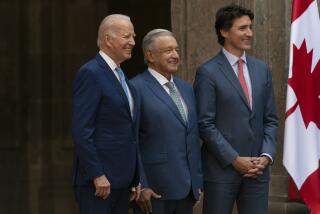Debt Plan a Turning Point, Now Central Brain Needed
- Share via
Mexico and Morgan Guaranty Trust Co. last week agreed on a scheme, endorsed by the U.S. Treasury, to write off $5 billion to $10 billion of the $78 billion that Mexico owes to international banks. While the amounts involved are modest, the principle underlying the cooperative agreement marks a major conceptual and political turning point in the five-year-old debt crisis.
Until last week the big banks and the U.S. government had insisted that the major debtor nations could and should fully service their massive debts, and that moderate amounts of new lending were the best way to tide countries over while they worked to boost export earnings. The new approach, rather than piling on new debts, would slice the existing stock of debt.In effect, Morgan Guaranty and the U.S. Treasury have joined the debt-relief club.
Under the creative Mexican-Morgan initiative, Mexico will offer to exchange its debts for up to $10 billion worth of 20-year Mexican bonds at 50 to 70 cents on the dollar. The new Mexican paper will be backed by an equal amount of U.S. Treasury bonds, which Mexico will purchase with $2 billion down and place in safekeeping with the U.S. Federal Reserve Board. Thus, with $2 billion, Mexico could retire about $7 billion in debt.
The Mexican-Morgan debt-reduction proposal comes amid widespread recognition that the old debt strategy was crumbling. Commercial bankers have become increasingly reluctant to throw good money after bad. And after five years of austerity packages, the three major debtors--Argentina, Brazil and Mexico--are drowning in surging, triple-digit inflation.
Aware of the deepening fatigue and frustration among both creditors and debtors, the big banks last year set aside more than $10 billion in reserves against potential Third World losses. This provisioning altered the outlook of both the U.S. government and the debtor nations. With the banks resting on firmer capital bases, the U.S. Treasury was freer to help broker solutions to benefit debtors and creditors alike. And developing nations judged that at least some banks were financially and psychologically prepared to accept losses. By gaining the cooperation of Morgan, Mexico isolated the remaining hard-line New York banks and effectively cracked the debilitated creditor cartel that had commanded the debt strategy since 1982.
Who will be the winners and losers in the Mexican-Morgan deal? If its debt-for-bonds exchange is fully subscribed, Mexico will cut its annual interest bill to the banks by roughly 8%, or $500 million. The U.S. government is another winner: By lending $2 billion to purchase the 20-year bonds, Mexico helps fund our fiscal and trade deficits, and a stronger Mexican economy can purchase more U.S. exports. The U.S. bond sale will be at market rates, so thisis no bail-out at the expense of American taxpayers. The only losers are the banks in the short term, but the exchange will leave participating banks with cleaner books and more secure, if discounted, assets.
The Mexican-Morgan initiative is responsive to the sour mood on Wall Street and the increasing assertiveness in Latin America, but it is only a first step toward constructing a new debt regime. To make a meaningful dent, such loan-securities exchanges must be broadened in size and scope to include other debtor nations. Ways also must be found to permit willing banks to combine asset exchanges and new loans for the more creditworthy countries.
The Mexican model can most readily be replicated by countries with substantial reserves--like Chile, Venezuela and South Korea. But nations having low reserves will either have to persuade creditors to accept other forms of collateral or will have to borrow the money. Japan, West Germany and the World Bank are potential sources of credit and guarantees. Still other debtors may require a combination of loan-securities exchanges, new capital and interest-rate ceilings on old debt.
In this complex, case-by-case world, a central brain will be needed to ensure fairness and order as creditors and debtors choose from this expanding menu of options. The World Bank and the International Monetary Fund are well placed to help design new debt packages that limit net debt service--debt service minus new lending--to levels consistent with renewed investment and growth in debtor nations. The World Bank and the IMF could fix debt relief at levels that do not threaten the solvency of the commercial banks. Both objectives are central to the concerns of the two agencies, which are the logical mediators in this next, more hopeful stage in the management of Third World debt.
More to Read
Sign up for Essential California
The most important California stories and recommendations in your inbox every morning.
You may occasionally receive promotional content from the Los Angeles Times.













